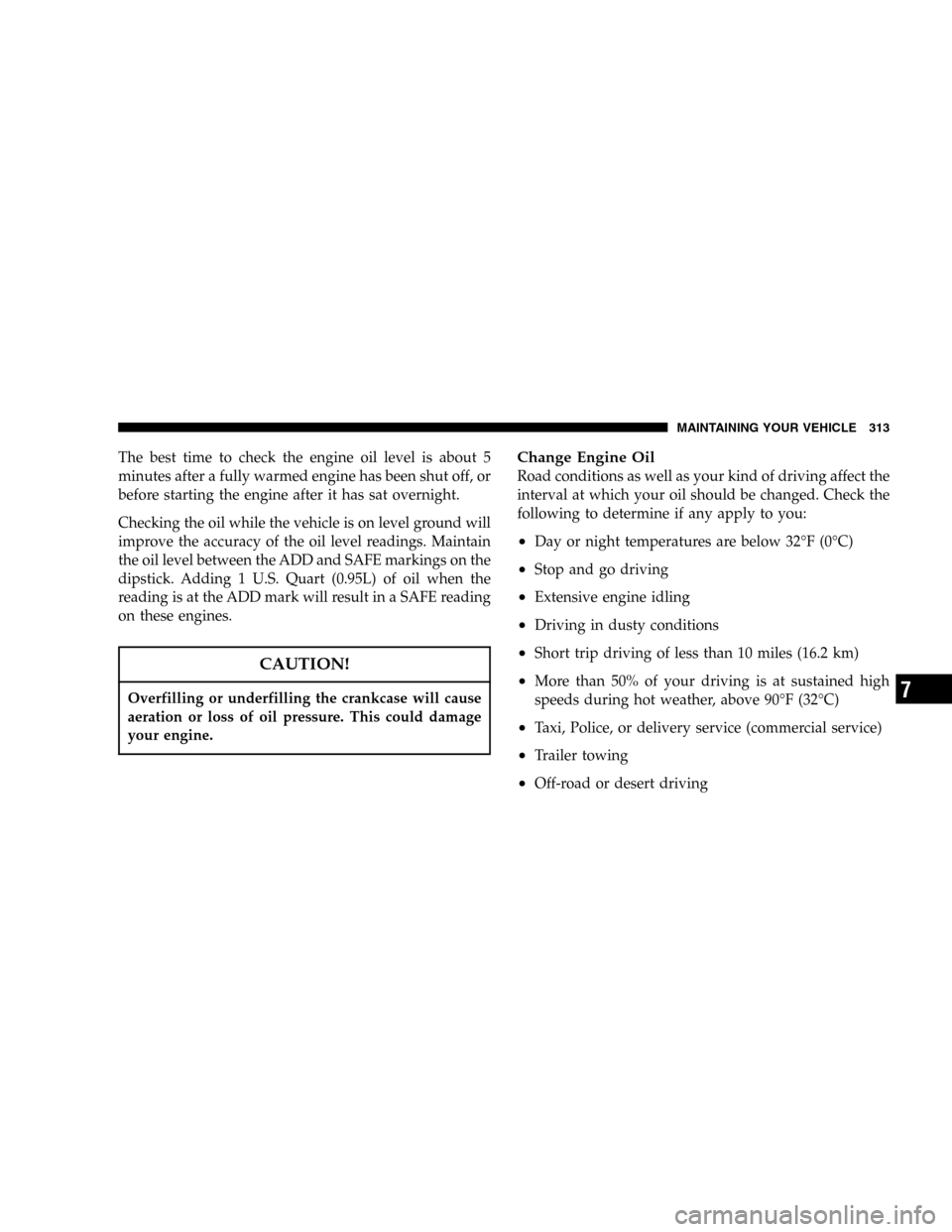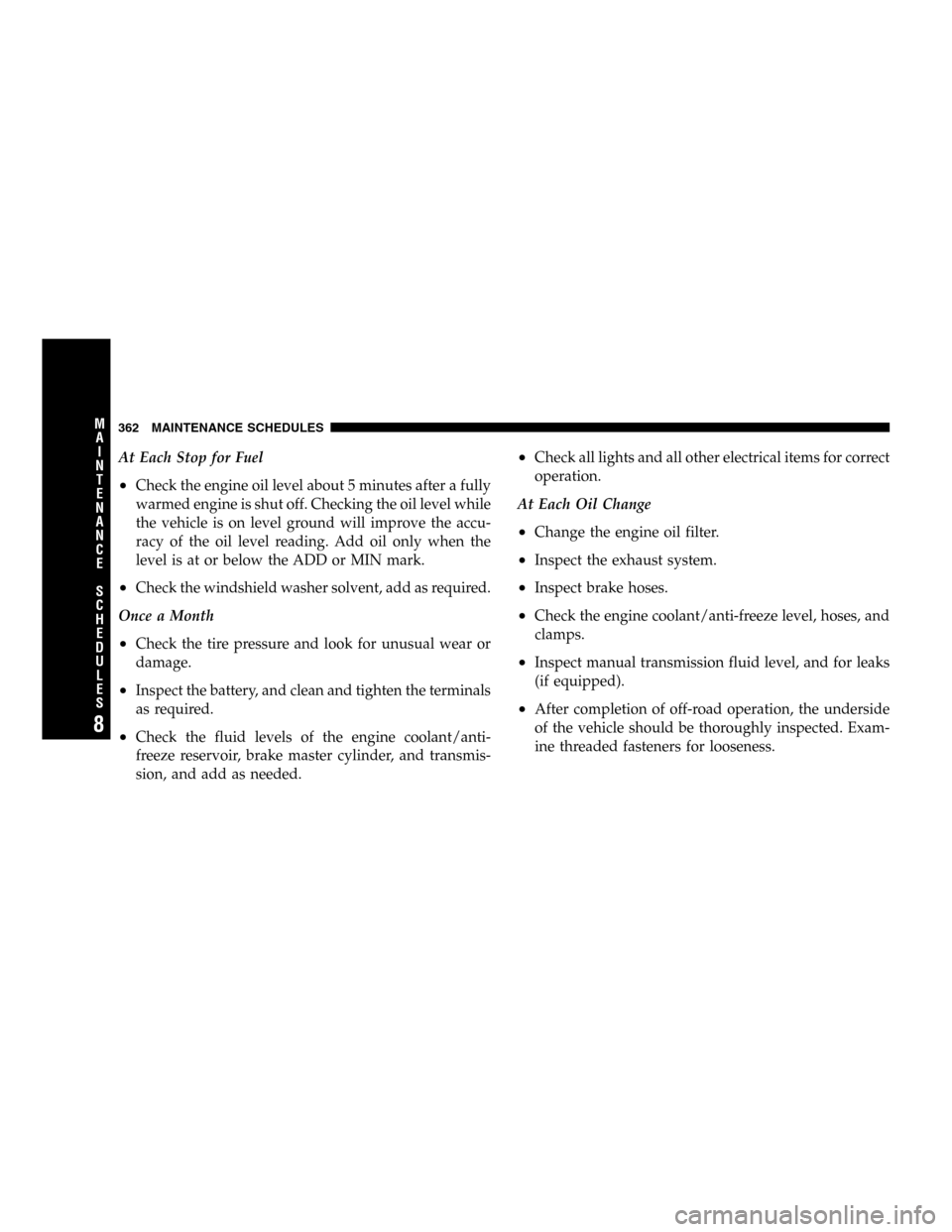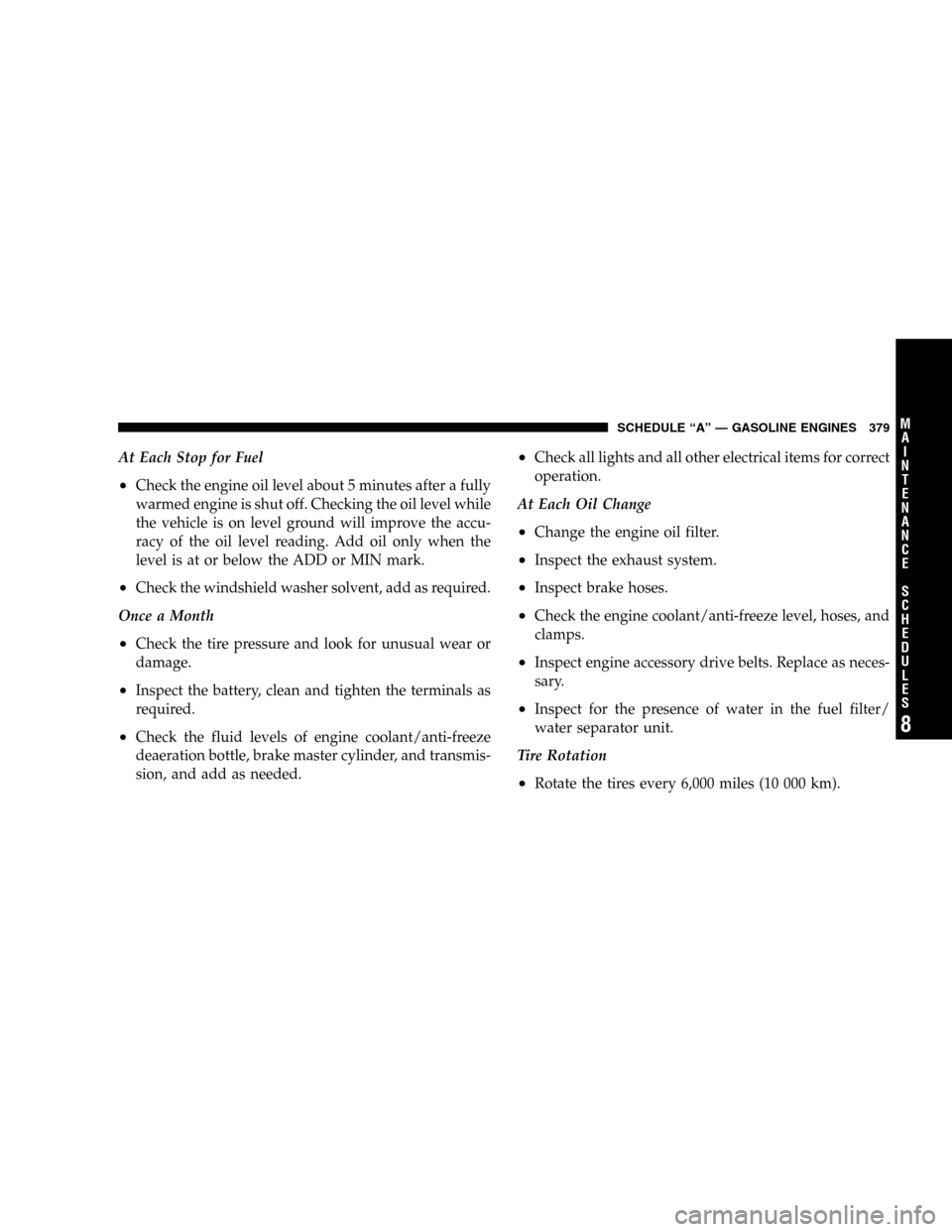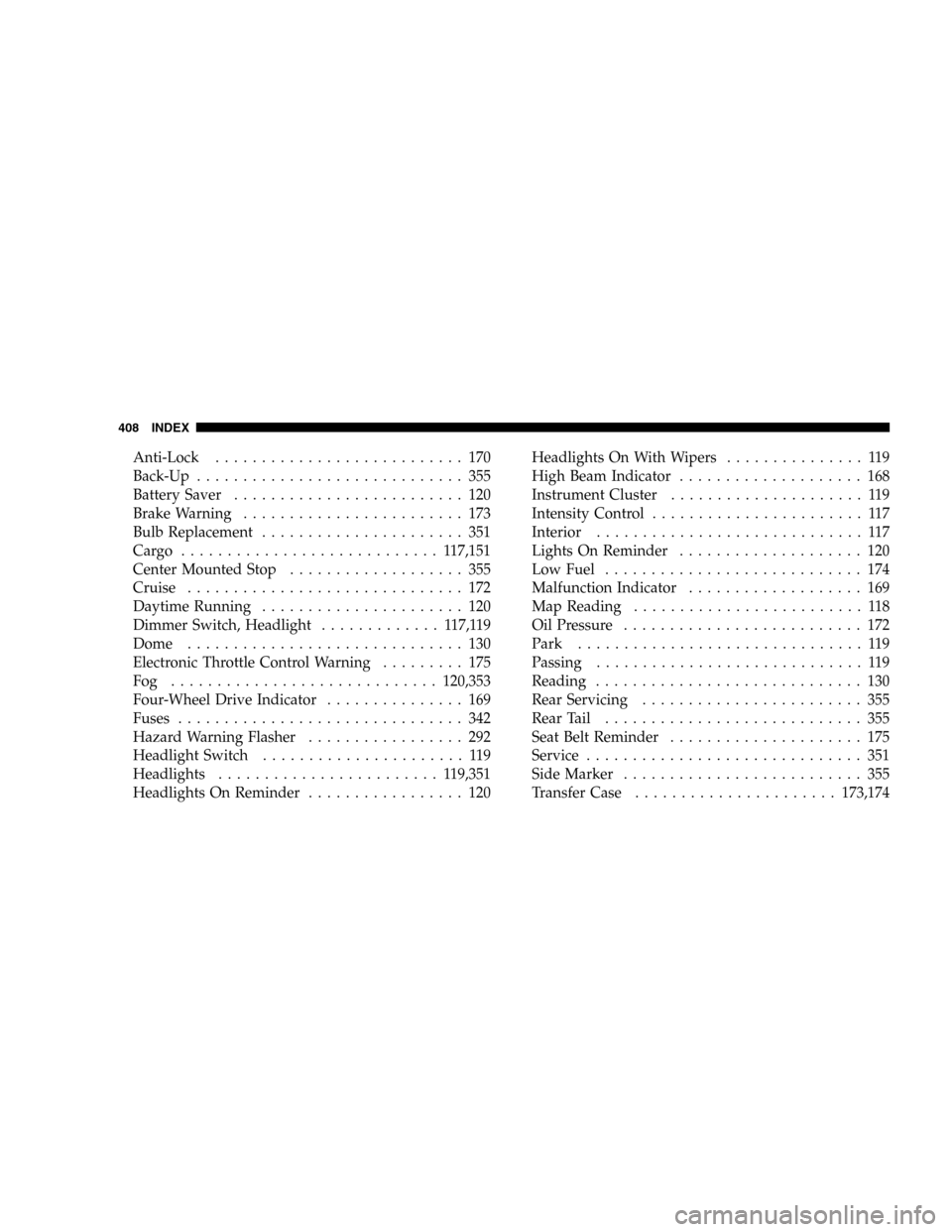Page 75 of 424
Defrosters
Check operation by selecting the defrost mode and place
the blower control on high speed. You should feel the air
directed against the windshield.
Safety Checks You Should Make Outside The
Vehicle
Tires
Examine tires for excessive tread wear or uneven wear
patterns. Check for stones, nails, glass, or other objects
lodged in the tread. Inspect for tread cuts or sidewall
cracks. Check wheel nuts for tightness and tires (includ-
ing spare) for proper pressure.
Lights
Have someone observe the operation of all exterior lights
while you work the controls. Check turn signal and high
beam indicator lights on the instrument panel.
Fluid Leaks
Check area under vehicle after overnight parking for fuel,
coolant, oil or other fluid leaks. Also, if gasoline fumes
are detected, the cause should be located and corrected
immediately.
THINGS TO KNOW BEFORE STARTING YOUR VEHICLE 75
2
Page 172 of 424

EVIC display (not in the instrument cluster). For addi-
tional information, refer to “Overhead Console — If
Equipped” in Section 3.
U.S. federal regulations require that upon transfer of
vehicle ownership, the seller certify to the purchaser the
correct mileage that the vehicle has been driven. There-
fore, if the odometer reading is changed during repair or
replacement, be sure to keep a record of the reading
before and after the service so that the correct mileage can
be determined.
14. Cruise Indicator Light
This indicator lights when the speed control
system is turned ON.
15. Oil Pressure Warning Light
Shows low engine oil pressure. The light will come
on and remain on when the ignition switch is
turned from the OFF to the ON position, and the lightwill turn off after the engine is started. If the bulb does
not come on, have the system checked by your autho-
rized dealer.
If the warning light comes on and remains on while
driving, stop the vehicle and shut off the engine. DO
NOT OPERATE THE VEHICLE UNTIL THE CAUSE IS
CORRECTED. Also, a single chime will sound.
16. Transmission Temperature Warning Light
This light indicates that there is excessive trans-
mission fluid temperature that might occur with
severe usage such as trailer towing or snow plowing. If
this light comes on, stop the vehicle and run the engine at
idle or faster, with the transmission in N (Neutral) until
the light goes off.
172 UNDERSTANDING YOUR INSTRUMENT PANEL
Page 313 of 424

The best time to check the engine oil level is about 5
minutes after a fully warmed engine has been shut off, or
before starting the engine after it has sat overnight.
Checking the oil while the vehicle is on level ground will
improve the accuracy of the oil level readings. Maintain
the oil level between the ADD and SAFE markings on the
dipstick. Adding 1 U.S. Quart (0.95L) of oil when the
reading is at the ADD mark will result in a SAFE reading
on these engines.
CAUTION!
Overfilling or underfilling the crankcase will cause
aeration or loss of oil pressure. This could damage
your engine.
Change Engine Oil
Road conditions as well as your kind of driving affect the
interval at which your oil should be changed. Check the
following to determine if any apply to you:
•Day or night temperatures are below 32°F (0°C)
•Stop and go driving
•Extensive engine idling
•Driving in dusty conditions
•Short trip driving of less than 10 miles (16.2 km)
•More than 50% of your driving is at sustained high
speeds during hot weather, above 90°F (32°C)
•Taxi, Police, or delivery service (commercial service)
•Trailer towing
•Off-road or desert driving
MAINTAINING YOUR VEHICLE 313
7
Page 362 of 424

At Each Stop for Fuel
•Check the engine oil level about 5 minutes after a fully
warmed engine is shut off. Checking the oil level while
the vehicle is on level ground will improve the accu-
racy of the oil level reading. Add oil only when the
level is at or below the ADD or MIN mark.
•Check the windshield washer solvent, add as required.
Once a Month
•Check the tire pressure and look for unusual wear or
damage.
•Inspect the battery, and clean and tighten the terminals
as required.
•Check the fluid levels of the engine coolant/anti-
freeze reservoir, brake master cylinder, and transmis-
sion, and add as needed.
•Check all lights and all other electrical items for correct
operation.
At Each Oil Change
•Change the engine oil filter.
•Inspect the exhaust system.
•Inspect brake hoses.
•Check the engine coolant/anti-freeze level, hoses, and
clamps.
•Inspect manual transmission fluid level, and for leaks
(if equipped).
•After completion of off-road operation, the underside
of the vehicle should be thoroughly inspected. Exam-
ine threaded fasteners for looseness.
362 MAINTENANCE SCHEDULES
8
M
A
I
N
T
E
N
A
N
C
E
S
C
H
E
D
U
L
E
S
Page 379 of 424

At Each Stop for Fuel
•Check the engine oil level about 5 minutes after a fully
warmed engine is shut off. Checking the oil level while
the vehicle is on level ground will improve the accu-
racy of the oil level reading. Add oil only when the
level is at or below the ADD or MIN mark.
•Check the windshield washer solvent, add as required.
Once a Month
•Check the tire pressure and look for unusual wear or
damage.
•Inspect the battery, clean and tighten the terminals as
required.
•Check the fluid levels of engine coolant/anti-freeze
deaeration bottle, brake master cylinder, and transmis-
sion, and add as needed.
•Check all lights and all other electrical items for correct
operation.
At Each Oil Change
•Change the engine oil filter.
•Inspect the exhaust system.
•Inspect brake hoses.
•Check the engine coolant/anti-freeze level, hoses, and
clamps.
•Inspect engine accessory drive belts. Replace as neces-
sary.
•Inspect for the presence of water in the fuel filter/
water separator unit.
Tire Rotation
•Rotate the tires every 6,000 miles (10 000 km).
SCHEDULE “A” — GASOLINE ENGINES 379
8
M
A
I
N
T
E
N
A
N
C
E
S
C
H
E
D
U
L
E
S
Page 408 of 424

Anti-Lock........................... 170
Back-Up............................. 355
Battery Saver......................... 120
Brake Warning........................ 173
Bulb Replacement...................... 351
Cargo ............................ 117,151
Center Mounted Stop................... 355
Cruise.............................. 172
Daytime Running...................... 120
Dimmer Switch, Headlight............. 117,119
Dome.............................. 130
Electronic Throttle Control Warning......... 175
Fog .............................120,353
Four-Wheel Drive Indicator............... 169
Fuses............................... 342
Hazard Warning Flasher................. 292
Headlight Switch...................... 119
Headlights........................ 119,351
Headlights On Reminder................. 120Headlights On With Wipers............... 119
High Beam Indicator.................... 168
Instrument Cluster..................... 119
Intensity Control....................... 117
Interior............................. 117
Lights On Reminder.................... 120
Low Fuel............................ 174
Malfunction Indicator................... 169
Map Reading......................... 118
Oil Pressure.......................... 172
Park............................... 119
Passing............................. 119
Reading............................. 130
Rear Servicing........................ 355
Rear Tail............................ 355
Seat Belt Reminder..................... 175
Service.............................. 351
Side Marker.......................... 355
Transfer Case......................173,174
408 INDEX